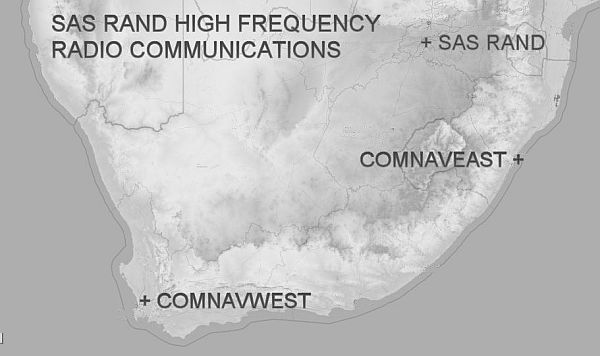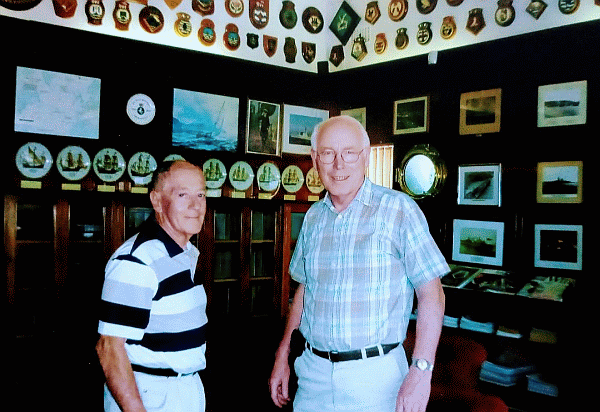

 The South African
The South African
Strange as it may seem, in the mid-1980s SAS Rand, the biggest Citizen Force (CF) naval base in the country, had no radio communications with anyone. Not even with its nearest army HQ at Witwatersrand Command and certainly not with any of the distant naval bases around South Africa’s coastline from Walvis Bay in the far west to the most important SAN communications centre at Silvermine, about mid-way between Cape Town and Simon’s Town, or up the east coast to Durban.
The initiative to rectify this serious shortcoming came from Ken Baker, then serving, during his spare time, as a Citizen Force (CF) Technical Officer at SAS Rand. Since good radio communications are crucial to any country’s armed forces, it was both strategically and tactically important that SAS Rand should come ‘on the air’ and Ken Baker and his team keenly appreciated how isolated the naval base at Wemmer Pan was. In his formal motivation to his Commanding Officer, Lt-Cdr Baker spelt out the requirement and proposed a solution.
Baker’s responsibilities ranged across all matters of radio, radar and other electronic specialities, as well as general electrical matters affecting the Navy’s base at Wenela in the Caprivi. He readily appreciated the challenge he was facing if that radio communications system at Rand had to function for 24 hours a day, if needs be, and, naturally, on any day of any year. In those days, long before South Africa had access to the array of satellites now circling the globe, the only possible means of achieving communications over many hundreds of kilometres was by high-frequency (HF) radio which is totally dependent upon the vagaries of the ionosphere. The ionosphere consists of a number of regions of ionised gas extending from about 50 to around 500 km above the earth and its radio-related characteristics are highly dynamic because they are under the direct influence of the sun. Hence, unsurprisingly, the ionosphere’s key parameters change significantly between day and night, with the seasons, with geographical location and over the period of the 11-year sunspot cycle. In view of all this variability it is necessary, in order to establish and then to maintain unbroken communications between distant stations, that each of them must be able to operate on any number of appropriate frequencies. The South African Navy communications specialists knew all about this and so they would allocate such frequencies as required.

Map
Into action
Once permission had been granted to proceed, Baker set about acquiring an appropriate radio transceiver for the base at Wemmer Pan. For many years K.Baker Associates had been a supplier of some of the most sophisticated electronic test, measurement and communications equipment manufactured, mainly in the USA and the UK, to South Africa’s electronics industry, its research institutes such as the CSIR, and the universities. And he had the contacts. He persuaded the local CEO of one of those companies to give him, personally on permanent loan, a state-of-the-art HF radio transceiver capable of 100W output. As all will remember, the United Nations arms embargo against South Africa that had come into force in 1977, had lost none of its teeth in 1984, and so this clandestine transfer of radio equipment to K W Baker Esq remains as much a secret today as it was then. The objective was now set in stone if not in salt water. It was to prove that SAS Rand could be in radio contact with Silvermine (Comnav-West), 1430 km away, and Durban (ComnavEast) at a distance of 500 km. But before this could happen there was need for an effective antenna. Only then could the training of its communicators commence in the seven newly constructed voice-procedure cubicles.
A broadband antenna
No matter how sophisticated the radio equipment is, it is useless without an adequate (and appropriate) antenna. For that Ken Baker turned to the Army/academia in the person of Brian Austin, then serving as SO2 Tactical Communications at Witwatersrand Command but whose day job was at the other place named after the Ridge of White Waters, Wits University, where he was a senior lecturer in electrical engineering specialising in antennas and radio propagation. Austin considered the requirements to be met at Wemmer Pan and specified a broadband travelling wave dipole. This particular type of antenna was originally conceived in Germany but it was in Australia that it was developed to meet the needs of the Royal Flying Doctor Service and the Schools of the Air – both of which were activities unique to that massive though sparsely-populated continent.
From the outset it was realised that the antenna had to be able to radiate effectively over a very wide range of frequencies. In essence these extended from perhaps as low as 3 MHz for use at night to one as high as 15 MHz during the day, both of which depended on the prevailing state of the ionosphere above South Africa at the time communications were required. As night falls so the frequency required for reliable communications during the day drops sharply as the ionosphere became less effective as a reflector of radio signals. Conditions then stabilise but reflection off one or more of those ionised layers only occurs when the radiated signals are at a considerably lower frequency. Thus, as a bare minimum, any given radio circuit will require at least two frequencies, one for the day and another for the night. However, things become even more complicated when the sun rises and, naturally, when it sets. During these brief periods of rapid solar change there is also a need for a third so-called transition frequency roughly mid-way between those other two. The antenna that best satisfied those frequency criteria and the additional very practical demands of both accommodating it, and erecting it without recourse to cranes, riggers and such like, was what is now known as the “Australian Dipole”. It was around 37m long and consisted of two (substantial) parallel wires kept 1.8m apart by means of insulated spaces at regular intervals. At its centre was a transmission line that connected the antenna to the radio equipment. Two thirds of the way along the wires, left and right from the centre point, was some electronic circuitry contained in two small boxes whose details need not detain us here. Their purpose was to force this wire antenna to become a broadband radiator and receiver of electromagnetic energy.
Once Ken Baker had seen the technical drawings and had given his approval, construction began. It was handled by two of his junior officers, Sub-Lieutenants A. Auditore and N.T. Middleton, both engineers in civilian life who would apply their skills to building the antenna for the Navy. Auditore, an electrical power engineer, took on the heavy engineering of configuring the wires, their dimensions and their method of separation while Middleton, an electronics engineer, concerned himself with the devices contained within those two boxes mentioned above.
The completed antenna was an impressive sight resembling, as Austin said, “an Eskom powerline”. It was eventually hauled up and supported by 10m high steel poles above the parade ground at “Rand” and its feedline was then connected to the transceiver down below. To those old salts who may remember such things, the antenna resembled the sorts of aerials seen on the battleships of the world’s navies during the Second World War, and even earlier. They hung between the ship’s masts and were connected from their mid-point, or perhaps one end, to the wireless room where “Sparks”, as he was always known, pounded the Morse key.
Testing testing ...
Now the crucial testing began. By the good offices of our day job employers (though the details and purpose of the enterprise were unbeknown to them) a sophisticated piece of electronic instrumentation, known as a vector-impedance meter, was hooked up to the transmission line that would eventually feed power from the transmitter to the antenna and which would also carry the very weak signals from afar to the receiver. The measurements were necessary to ensure that the antenna was truly a broadband device as its Germano-Aussie designers would have us believe it was. Austin and Middleton carried out the measurement while Baker and Auditore watched with more than a little interest. When the results were finally displayed in graphical format, they showed that the antenna did indeed behave as its designers had claimed: it was ‘broadband’ and covered the HF spectrum, as intended. The key date on which this happened is worth recording, at least for posterity’s sake. It was 4 August 1984. In his report to his commanding officer Lt-Cdr Baker reported the success achieved to date but pointed out that the next and most crucial tests – actual radio contact with Comnav-East and Comnav-West -would depend on the allocation, from on-high, of the appropriate frequencies. He trusted that this could be expedited soon. It was and SAS Rand’s HF radio communications then became fully operational.
Science, and indeed engineering, never stand still even though the machinations of mere mammon can cause all manner of delays. Baker’s next report to his CO was written some two years later. In it he reported on very successful communications with both Silvermine and Durban.
Reception was ‘loud and clear’ (S5+ in the jargon) on two of the six frequencies that were tested. Since those frequencies were disguised by coded numbers none is available for disclosure to the curious but we can be sure that those optimum frequencies would have been determined, without a shadow of doubt, by the prevailing conditions some hundreds of kilometres up above in the layers of the ionosphere.
And, of much interest too, was Ken Baker’s comment that, in the interim, Brian Austin and his colleagues at Wits University had developed an improved version of the antenna, which was more compact, was considerably lighter and which sur-passed the performance of the impressive structure at Wemmer Pan. This new antenna, so Baker said, offered much promise for other SAN installations whether at sea or on land.
And, in the meantime, SAS Rand at Wemmer Pan was also in regular communications, via VHF, with Group 18 of Witwatersrand Command. Those many long years of being incommunicado were now behind it.
About the Authors
Lt Cdr (Ret) Ken Baker served in the SAN for 27 years having first been called up for what was then called the Active Citizen Force (ACF) in 1949. He initially found himself in the army but applied for a transfer to the SAN where he served as a seaman telegraphist until his discharge in 1952. In 1979 he found himself back in uniform when people with his technical skills were in great demand by the SADF. He spent time at Salisbury Island involved with radar and set up a training course for radar operators at SAS Rand. In addition, he twice visited the Marine Base at Wenela in the Caprivi Strip to improve its radio communications.

Ken Baker and Brian Austin in the Seven Seas in Simon’s Town
The account above describes his major contribution to radio communications at SAS Rand. In between Ken Baker ran a number of very successful ‘hi- tech’ electronics equipment supply and manufacturing companies from his base in Johannesburg.
Brian Austin served in the South African Corps of Signals (Citizen Force) for twelve years. His final appointment, as a major, was at Witwatersrand Command HQ in Johannesburg. There he had had full responsibility for the tactical communications requirements of the Command and had particular involvement with the large number of CF members whose training and promotion were one of his functions. Numerous exercises were held within the confines of Witwatersrand Command, one of which involved this technical activity with the SAN at SAS Rand.
He has lived in England since 1987
Return to Journal Index OR Society's Home page
South African Military History Society / scribe@samilitaryhistory.org